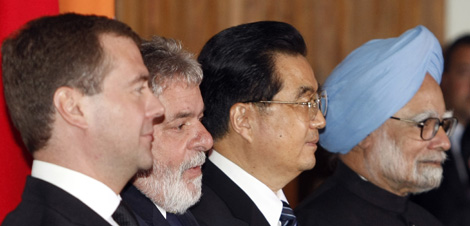China’s Friends Indeed?
More on:

Back in December, I argued on this blog that the United States (in both the Bush and Obama administrations) had positioned itself squarely at the center of efforts to reform the international architecture to reflect today’s realities of power and capacity.
In an interesting blog post today, my colleague Liz Economy goes in a somewhat different direction. Liz argues that China is, in some ways, holding together a series of “informal alliance[s]” that will create a “new brand of geopolitics.” And she writes about this evocatively:
(1) “China has decided its new best friends forever are going to be Brazil, Russia, South Africa, and India.”
(2) They are “tackling the tough issues of the day, including reforming the global financial system, sanctioning Iran, and combating climate change.”
(3) And at least some of their “initiatives seem dedicated only to limiting these countries’ broader responsibilities to the global community.”
Of course, Liz is joking about "best friends forever." And, as Liz argues persuasively, "these countries possess radically different political systems and in some cases have long-standing rivalries and mistrust between them."
But I’d go further--and broaden the argument on all three counts.
(1) I don’t think these countries are really China’s friends, nor are they likely to become especially close friends in the future.
(2) I think the influential decisions on the tough issues of the day are mostly being made elsewhere, not in groupings like BRIC* and BASIC†—and with the United States, Europe, and Japan very much in the room. Reform international finance without the United States, Japan, and Europe? Unimaginable. (I’d add that the toughest issues certainly can’t be tackled without China, either).
(3) And one of the principal reasons these countries aren’t shouldering the burden of providing public goods is because the United States continues to provide so many of them, especially when it comes to global security. China, for example, free rides on these public goods, quite simply because it can. So if the United States starts to pull back, the BRIC countries will face much tougher choices and find coordination, such as it is, even harder.
In short, I don’t see any of these groups—BRIC, BASIC, or others—as “informal alliances” at all, in part because the relationships among these countries already include so many competitive, not just cooperative, elements.
The coming era of major power relations is going to be very complex indeed. Both Washington and New Delhi (and, for that matter, Moscow, Tokyo, and Brussels) are more than a little ambivalent about the rise of Chinese power. So, as I wrote in the March-April issue of Foreign Affairs, for instance, many in India deeply fear that the United States looks to address global issues bilaterally with China, fearing that this will sideline New Delhi and work against Indian interests. For all the coordination between China and India on climate change, especially at last year’s Copenhagen summit, climate is, I think, a unique case because Chinese and Indian interests on the demand side of climate change—targeted emissions reductions—so naturally and sensibly align.
But beyond Copenhagen, the BRIC and BASIC countries actually have much less in common.
For one thing, their economic structures are different: China exports; India relies heavily on domestic demand. Russia produces energy; China and India consume it. China manufactures; Russia and South Africa depend heavily on commodities.
Take energy, in particular: Since Russia produces while China and India hungrily consume, it’s hard to imagine these countries having the same interests on, say, oil and gas prices, much less forging an alliance or cartel. Indeed, Chinese and Indian interests are actually far more closely aligned with those of the United States, Japan, and Europe. Unlike Russia, these countries are major consumers whose interests closely align around low prices, secure supplies, expanded supplies, and diversification into alternatives and renewables.
So where do the interests of the BRIC and BASIC countries align, anyway?
The most important area, I think, is in their shared sense that the international architecture needs to accommodate new powers, particularly them.
But the United States is long past accepting that new reality. Indeed, it’s the United States that has often taken the lead in trying to make that happen:
George W. Bush’s administration championed significantly expanded involvement in the International Energy Agency for Beijing and New Delhi, then quickly ran up against resistance from small European countries, whose weighted voting shares will be reduced if these Asian giants join the organization. The Bush administration endorsed the G8 Plus Five. And after resisting formal G8 expansion, the U.S. eventually began in 2008 to shift its emphasis away from the G7 toward the more inclusive G20.
The Obama administration has gone even further. Just read some of Hillary Clinton’s speeches … At last year’s Pittsburgh G20 summit, Obama’s administration solidified the shift from the G8 to the G20 as the new high table of the international economy. It worked to reweight voting shares in the major international financial institutions. And it helped to create the Financial Stability Board, which includes both China and India.
Now, contrast that with the dynamics among the BRIC and BASIC countries. Seriously, what’s China doing to promote India’s international profile? And will China ever endorse a UN Security Council seat for India?
I doubt it.
* BRIC: Brazil, Russia, India, and China
† BASIC: Brazil, South Africa, India, and China
More on:
 Online Store
Online Store